New products at Crocus
by Sarah - May 16th, 2009.Filed under: Crocus, New Products.
New items today at Crocus
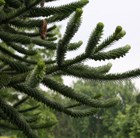
Monkey Puzzle £29.99
Position: full sunSoil: fertile, moist but well-drained soilHardiness: fully hardyA distinctive, evergreen, coniferous tree with whorls of branches and pointed, lustrous, bright green leaves maturing to dark green. The monkey puzzle tree is best planted as a focal point on a lawn or in a small group since it doesnt look good among other hardy trees. Once established it will grow to a height of 25m or more, making it only really suitable for a large garden or park.Garden care: No pruning is needed. Keep well watered in its first year of growth.

one pelargonium £12.99
Position: full sun or partial shade Soil: fertile, well-drained soilRate of growth: fast growing Flowering period: April to SeptemberFlower colour: red Other features: attractive foliage Hardiness: tenderThis gorgeous pelargonium has glowing, ember-red flowers that are held in open heads above mounds of attractive foliage. Each red flower is subtly ghosted with deep red markings that emphasizes the radiant effect. It looks fabulous in a pot on the patio or conservatory.'Ardens' will be dispatched directly from our specialist grower of rarer pelargoniums. As soon as you receive the plant you will need to pot it up into a larger pot or plant it in to their final pot straight away. A great hot tip is to feed your plants every other day with a weak solution of a potash-rich liquid fertiliser, such as Tomorite. You'll be rewarded with masses of flowers throughout the summer on plants about 30-40cm tall.
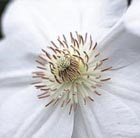
clematis (group 2) £8.99
Position: full sun or partial shadeSoil: fertile, well-drained soil, neutral soilRate of growth: averageFlowering period: June and AugustFlower colour: creamy whiteHardiness: fully hardyA compact clematis with large, creamy white flowers with prominent brown anthers borne from June and August. A lovely, easy-to-grow climber that is perfect for growing up a sunny wall, over an arch or even through a neighbouring tree. It looks particularly stunning when grown against a dark background.Garden care: Remove dead and damaged stems before growth begins in early spring, cutting all remaining stems back to where strong buds are visible. Apply a slow-release balanced fertiliser and a mulch of well-rotted garden compost around the base of the plant in early spring.
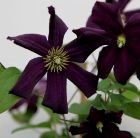
clematis (group 3) £8.99
Position: full sun or partial shadeSoil: fertile, well-drained, neutral soilRate of growth: average to fastFlowering period: July to SeptemberFlower colour: deep violetHardiness: fully hardyAn unusual clematis with very deep violet, almost black flowers with contrasting pale yellow stamens. The blooms are produced from July through to September and looks particularly attractive when planted against a light background or growing through yellow-leaved shrubs. Prune back in early spring to a pair of strong buds about 20cm above ground level.Garden care: In early spring cut back the previous year's stems to a pair of strong buds about 15-20cm (6-8in) above ground-level and apply a slow-release balanced fertiliser and a mulch of well-rotted garden compost around the plant, avoiding the immediate crown.
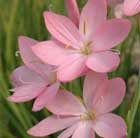
kaffir lily £5.99
Position: full sunSoil: moderately fertile, moist but well-drained soilRate of growth: fast-growing Flowering period: August and September Flower colour: pale pinkOther features: excellent cut-flowersHardiness: hardy although flowerspikes are vulnerable to frost damageStiff, upright stems of pale pink, gladiolus-like flowers in August and September above clumps of sword-shaped, mid-green leaves. This pale pink kaffir lily is excellent for the middle of a sheltered sunny, moist but well-drained border. Earlier-flowering than many other varieties, it provides vertical interest and a supply of cut-flowers for use indoors.Garden care: Apply lots of well-rotted garden compost or manure when planting. Water during dry spells and dead-head regularly. After flowering remove the faded flower-spikes and protect the crown of the plant with a deep, dry winter mulch. Lift and divide congested plants every two or three years in spring.
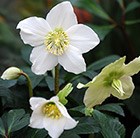
Christmas rose £5.99
Position: partial shadeSoil: heavy, neutral to alkaline soil including heavy soilRate of growth: average Flowering period: January to AprilHardiness: fully hardyDespite its evocative name, this lovely hellebore is rarely in flower by Christmas. But the white, bowl-shaped flowers are well worth waiting for, brightening up those dark winter days. The flowers appear on short stems, are sometimes flushed with pink, and unusually for hellebores, are usually upturned rather than nodding. They last for two to three months, and the handsome evergreen foliage is deeply cut and dark green. One of the earliest flowering plants, this is best planted in groups at the front of a partially shady mixed border, or beneath deciduous shrubs among spring-flowering bulbs. In former times, hellebores were planted close to cottage doors to prevent evil spirits from crossing the threshold.Garden care:A top tip from the Crocus crew is to cut back the old leaves down to the ground in January or February. This will show off the emerging flowers to best effect and it also helps to get rid of foliar diseases such as Hellebore leaf spot. Add lots of well-rotted leaf mould, compost or manure to the planting hole. Apply a generous 5-7cm (2-3 in) mulch of well-rotted organic matter around the base of the plant in autumn and providea top-dressing of general fertiliser each spring.
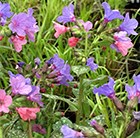
lungwort £5.99
Position: partial shadeSoil: humus-rich, moist, well-drained soilRate of growth: averageFlowering period: February to MayFlower colour: bluish-lilacOther features: marbled, hairy leavesHardiness: fully hardyThis handsome Jerusalem sage produces bluish-lilac flowers from late winter to late spring. Considered one of the best pulmonarias for foliage, the mid-green leaves are marbled and hairy to touch. An excellent groundcover plant for moist, shady spots, it looks great at the front of the border or for edging paths.Garden care: Lift and divide large clumps every three to five years after flowering or in autumn. Cut back plants affected by mildew to the ground, water and feed – the plant will regenerate and produce new leaves later in the year.
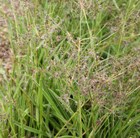
Great Woodrush £5.49
Dense slow-spreading tuft-forming grass with rich green leaves with cream edgeswith brown flower spikes in winter






